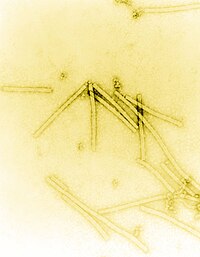
Photo from wikipedia
Low-temperature atmospheric-pressure air plasma is a source of charged and neutral gas species. In this study, N-carrying tobacco plants were inoculated with plasma irradiated and non-irradiated tobacco mosaic virus (TMV)… Click to show full abstract
Low-temperature atmospheric-pressure air plasma is a source of charged and neutral gas species. In this study, N-carrying tobacco plants were inoculated with plasma irradiated and non-irradiated tobacco mosaic virus (TMV) solution, resulting in necrotic local lesions on non-irradiated, but not on irradiated, TMV-inoculated leaves. Virus particles were disrupted by plasma irradiation in an exposure-dependent manner, but the viral coat protein subunit was not. TMV RNA was also fragmented in a time-dependent manner. These results indicate that plasma irradiation of TMV can collapse viral particles to the subunit level, degrading TMV RNA and thereby leading to a loss of infectivity.
Journal Title: Archives of Virology
Year Published: 2018
Link to full text (if available)
Share on Social Media: Sign Up to like & get
recommendations!